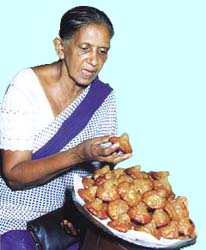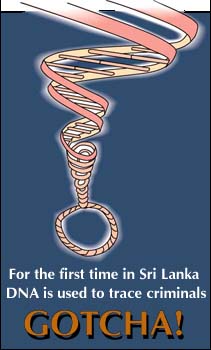 |
 11th April 1999 |
Front Page| |
 Dying delicacy |
Contents | |
 |
Gotcha!For the first time in Sri Lanka DNA is used to trace criminals By Feizal Samath and Kumudini Hettiarachchi
The decision to enforce the death penalty came on the heels of two brutal murder cases that shocked the public and compelled the government to move swiftly to instill public confidence in the judicial system. Laws were also tightened and bail made more difficult to secure. Some recent crimes have been horrendous. In February, a family of six including three girls were brutally murdered in their own home in broad daylight at Hokandara, by a gang, over a land dispute. The girls were also raped, but neighbours - fearing reprisals from the gang and that they may be friends of the police - took many hours to inform the nearest police station. Last October, women activists, outraged by the brutal gang-rape and murder of a newly-married Indian woman Rita Jones, took to street protests in Colombo seeking more protection for women and harsher punishment of sex offenders. Now comes news of a significant breakthrough in the fight against crime. A single hair, a bloodstain or a little bit of semen from a crime scene can lead the police very quickly to the suspect. It's been happening all over the world for sometime and now it's here in Sri Lanka. DNA testing - the near-miraculous technique of identifying culprits - has been used for the first time in the investigations of that heinous crime, the Hokandara murders. The DNA of one of the dead victims has been tested with bloodstains on the clothes of the accused at the Science Faculty of the University of Colombo and, according to a spokesman for the Attorney General's Department, a successful match has been made. "This is one of the biggest breakthroughs in crime-busting," the spokesman said. Though thousands of people have been convicted all over the world by DNA's unbelievable ability to search out suspects, this is the first time that DNA testing has been done in Sri Lanka in connection with a crime. DNA testing is a process that has been used elsewhere, especially in Britain and America, for identification of criminals and is considered even better proof than finger-printing. DNA (deoxyribonucleic acid), is self-replicating material, present in nearly all living organisms. DNA is unique to an individual (except in the case of identical twins). It does not change throughout a person's life and can be found in skin cells, blood, hair follicles, saliva and semen. It is a constituent of chromosomes, which are thread-like structures found in the cell nucleus and carry genetic information in the form of genes. Scenes of crime usually have some DNA samples - rapists leave behind semen, robbers who break into houses could cut themselves and bleed in a struggle with the victims, assailants may leave behind blood, hair or even skin scrapings. These are collected by forensic experts and matched with those of suspects to ensure identification. DNA testing is very costly. Some Sri Lankan experts in DNA have been conducting experimental testing for many years, but the work was all done only inside laboratories. The new technique has also led to a much quicker system of justice. The AG's office is now preparing to file indictment in the Hokandara case - once permission is granted for a trial-at-bar by the Chief Justice - by end April. "Rarely has a case been completed so fast, given its complexities," the spokesman said. The case took just three months to complete - far speedier than previous murder investigations - and most of the credit must go to DNA testing. Authorities have been considering the DNA method for a long time, but the cost has been prohibitive because of the expensive chemicals needed for such testing. The Government Analyst's Department, the AG's spokesman said, had also been urged to set up its own DNA lab but high costs cut into any such proposal. Costs apart, the Attorney General and the Police were prompted to resort to this unique method - which has become popular in the West due to its near 100 percent success rate in crime-busting - given public outrage and anger over mass murders, rapes and other gruesome crimes. "This was a special case and public antipathy to the system was growing. We needed to do something to restore confidence in the law and order structure," the official said. The Attorney General's office has also become pro-active in the race against crime and intervenes when criminal investigations are seen slowing down, like in the case of Hokandara. "We moved into this case, about three to four days after the incidents, when we found the police were getting nowhere in the investigations," the spokesman said. This, according to sociologists who blame a police-criminal-politician nexus for the rise in the crime rate, was curious since everyone knew the alleged killers, and one of them had also died in the struggle which had ensued with the son of the slain family. But the spokesman noted that the problem confronting police was lack of evidence, and "then we thought of DNA to find more conclusive proof". Government investigators say the tests conducted in the Hokandara case were not the full one, due to the costs involved. "The DNA testing would have cost at least Rs. 30,000 and was marginal to the full process," one investigator said. In the Hokandara case, nine sites were identified in the blood and compared with the bloodstains on the clothes. Usually in other countries, the "short-tandem-repeat" method is used to analyse such samples, but Sri Lankan experts were not available to confirm whether they used the same method. To streamline sampling, this method identifies subjects not by the entire genetic blueprint, but by tiny stretches of DNA coding known as short tandem repeats (STRs). These STRs are just two to seven base-pairs long and give quite accurate results. According to international reports on the DNA process, if three of the mini-strands match those of a suspect, the likelihood is 2,000 to 1 (one) that it is the right person. Nine matches boost the odds to 1 billion to 1 (one). Technicians can obtain a usable quantity of DNA from the saliva on a cigarette butt or a single hair root, they added. The most recent case of a much awaited DNA verdict was that of US President Bill Clinton being identified as the source of the most famous dress stain in the Monica Lewinsky affair. The use of DNA testing opens a host of new possibilities for criminal investigators and if used widely, would be just the deterrent needed to fight crime. DNA's success has a near-100 percent accuracy rate except in the case of twins, or a one in a billion chance of going wrong. Long delays in concluding criminal investigations - one of the reasons for a rising crime rate — have been blamed on old techniques used in investigations to seek evidence. The Government Analyst's office can only identify the origin of human blood or hair. But in the case of DNA testing the possibilities are limitless. DNA tests can be carried out on bloodstains, on weapons used in murders like knives, semen or seminal fluid contained in the vagina of a rape victim. "This is a remarkable weapon to use in the fight against rape. A swab of fluid from the vagina can be tested against the semen of an accused person, which was not in our books hitherto," the AG's spokesman said. The new process, however, is certain to be fully scrutinized during the Hokandara murder trial. The experts who conducted the DNA tests would come under intense cross-examination by defence attorneys, and even court, and the question of this evidence being admissible in a court of law is certain to arise. "I don't think that is a problem," argued the AG's spokesman. While DNA testing has finally come to Sri Lanka, the question arises now as to whether this expensive process would be used in all criminal investigations. "I don't know. That is a difficult question. The cost is very prohibitive but I think the government must look at this issue seriously because DNA testing is one of the ways to halt the crime rate and quickly conclude investigations. In a way, by doing that, we are also cutting costs to the exchequer," the AG's spokesman noted.
More Plus * Freedom sought, freedom denied
Front Page| News/Comment| Editorial/Opinion| Business| Sports | Mirror Magazine |
|
 |
Please send your comments and suggestions on this web site to |
|
 Troubled
by growing public anger over a series of unsolved crimes and blatant misuse
of easy bail conditions by criminals, the government two months ago brought
back the death penalty.
Troubled
by growing public anger over a series of unsolved crimes and blatant misuse
of easy bail conditions by criminals, the government two months ago brought
back the death penalty.